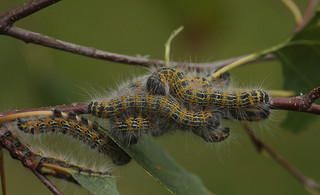Week 10th – 17th June 2013
How did you do with this week’s Mystery Creature? This charming moth is called a “Buff tip” (Phalera bucephala).
| Image Credit: Michael Bell (Nature Learn) |
|
As most moths are nocturnal they need to rely on good hiding areas or camouflage to survive during the day. The Buff tip is a true master in the art of camouflage. Not only does its colour and markings blend in among the branches of the trees upon which it rests but its body shape is also ideal to make it look just like a twig.
These moths are fairly common in Ireland and throughout Europe. They have a wing span of between 4 and 7 cm. The Buff -tip over winters in the crysalis state underground, emerging in adult form in early Summer. The female lays large groups of eggs which hatch en-masse. The black and yellow larvae tend to feed in large groups after hatching, moving towards a more solitary lifestyle as they grow. They feed on a variety of deciduous trees such as birch, hazel, alder and oak. In the Autumn they pupate underground and the cycle begins again.
 |
| photo credit: Deanster1983 via photopin cc |
These images (unless otherwise stated) were kindly provided by Michael of Nature Learn, a Nature Education program for schools and public groups. Keep watching for another Mystery Creature from Nature Learn in the coming weeks!